10 April 2010 - Polish Air Force 101
The Smolensk air disaster occurred on 10 April 2010, when a Tupolev Tu-154 aircraft of the Polish Air Force crashed near the Russian city of Smolensk, killing all 96 people on board. Among the victims were the President of Poland Lech Kaczyński and his wife Maria, the former President of Poland in exile Ryszard Kaczorowski, the chief of the Polish General Staff and other senior Polish military officers, the president of the National Bank of Poland, Polish Government officials, 18 members of the Polish Parliament, senior members of the Polish clergy and relatives of victims of the Katyn massacre. The group was arriving from Warsaw to attend an event commemorating the 70th anniversary of the massacre, which took place not far from Smolensk.

The pilots were attempting to land at Smolensk North Airport—a former military airbase—in thick fog, with visibility reduced to about 500 metres (1,600 ft). The aircraft descended far below the normal approach path until it struck trees, rolled inverted and crashed into the ground, coming to rest in a wooded area a short distance from the runway.
Both the Russian and Polish official investigations found no technical faults with the aircraft, and concluded that the crew failed to conduct the approach in a safe manner in the given weather conditions. The Polish authorities found serious deficiencies in the organization and training of the Air Force unit involved, which was subsequently disbanded. Several high-ranking members of the Polish military resigned, under pressure from politicians and the media.
Various conspiracy theories about the crash have since been in circulation, and are promoted by Law and Justice's leaders Jarosław Kaczyński (twin brother to Polish President Lech Kaczyński) and his deputy, Antoni Macierewicz, who claim the crash was a political assassination. As of 2011, Polish and Russian investigations did not report any evidence supporting this claim.
As the aircraft left Warsaw, weather conditions were rapidly deteriorating at Smolensk. A temperature inversion had developed, trapping moisture low in the atmosphere and causing a dense fog to develop. At 9:15 Smolensk time, about an hour and a half before the crash, a Yakovlev Yak-40 jet (flight PLF 031) also belonging to the Polish government and carrying Polish journalists from the President's press pool landed at the airbase without incident, though conditions were rapidly worsening at the time. Shortly thereafter, between 9:20 and 9:39 MSD, a Russian Ilyushin Il-76 (tail number 78817) made two attempts to land,[3] but because of low visibility, it diverted to Vnukovo Airport near Moscow. Upon PLF 101's approach to the base, atmospheric conditions continued to worsen, and the fog continued to thicken, further reducing visibility to 400 metres (1,300 ft). The ground control personnel stated to PLF 101 that there were no conditions for landing. The Captain then requested and was given permission to conduct a "trial" approach. The controllers instructed the captain as to the landing minimum of 100 metres (330 ft), to which the captain replied, "Yes, sir!".
Meanwhile, the situation in the cockpit was one of very high stress. As the weather continued to worsen, the crew became increasingly aware of the extreme difficulty they would encounter in landing at Smolensk. The crew may have feared a negative reaction from their passengers should they have to divert to an alternative airfield. The protocol director was present in the cockpit from time to time, and the Commander-in-Chief of the Polish Air Force was present in the cockpit for the final approach phase of the flight, including the crash itself. At one point, the navigator is heard on the CVR saying "He'll go crazy", a possible reference to the President of Poland, had the crew chosen to divert. There may also have been some friction between the Air Force Commander and the captain, caused by an absence of the latter from condition training.
The captain and first officer's decision making may have also been affected by knowledge of a 2008 flight when the President of Poland ordered a change in destination right before departure and again while airborne. The captain and first officer had been the first officer and navigator, respectively, on that flight. Lacking charts or a flight plan for the new destination, the captain of that flight had decided he could not bring the aircraft to the new destination safely. Disobeying the President and a high-ranking Polish Air Force commander on board, the captain flew on to the originally planned destination. The Polish prosecutor's office would later clear that captain of any wrongdoing in relation to that flight, and he was even awarded a silver medal of merit for national defense. However, in the final report issued by MAK (The Interstate Aviation Committee; Russian: Межгосударственный авиационный комитет, МАК) – a supervising body overseeing the use and management of civil aviation in the Commonwealth of Independent States (CIS), it was stated he had not been assigned to fly the President again since that time, though Polish sources note he flew the President to New York in September 2008, despite objections from the President. The captain involved in the 2008 incident flew the Polish Prime Minister to Smolensk on 7 April without the President on board, but he was removed from the crew of the 10 April flight which carried the President. Knowledge of the 2008 incident and its repercussions may have weighed on the crew of PLF 101, potentially placing additional pressure on them to complete their flight to the original destination.
Complicating the situation was the increased workload on the captain. Normally, one pilot flies the airplane while another crew member handles radio communications. On PLF 101, the responsibility for communication usually rests with the navigator. At Smolensk however the situation was different. As the airport is not usually open for international flights and is not ICAO certified, the air traffic controllers were not required to be fluent in English, the ICAO standard language for ATC communication. As such, all communication between Smolensk ATC and PLF 101 was carried out in Russian. Russian law requires international flights landing at military airports to have a Russian "Leaderman" (navigator; Russian lidirovshik) on board the flight, who is then responsible for all ATC communication, which is done in Russian. In the middle of March, as part of their request for permission to conduct the flight, Poland asked for "Leaderman" services and the latest airport data for Smolensk. At the end of March, after apparently receiving no reply to their first request, Poland tendered a second request for permission to fly, but did not request "Leaderman" services. As a spokesperson for the Air Force Command said: "The Russian side has not confirmed readiness to secure the flight leader". According to the Final Report, Russia did offer "Leaderman" services, but Poland refused, stating their crew had satisfactory knowledge of Russian and could conduct the flight without the Leaderman. In reality, the captain was the only member of the crew who could speak adequate Russian. Therefore, upon being handed off (transferred) to Smolensk ATC, the captain took over communication duties from the navigator. In a normal situation, this would dictate that the first officer be the pilot actually flying the airplane, but as the weather was bad the captain, as the most experienced member of the crew, elected to fly the airplane as well. Therefore, the captain was performing two tasks simultaneously which are usually split up, increasing his workload and requiring him to divide his attention.
Under these stresses, the crew continued their approach pattern and readied the aircraft for final descent. Radios were tuned to the two Non-Directional Beacons (NDBs) present at the field, and the autopilot was set up to use waypoints from the Flight Management System (FMS) units for navigation. The crew used their second radio to contact the Yak-40 which had landed earlier, inquiring as to the weather conditions. The Yak-40 crew replied, "Well, generally it's absolute shit here," and that, "(we) were lucky to land at the last moment." The Yak-40 crew estimated visibility was 200 metres (660 ft), but told PLF 101, "you might try...(to make an approach)." The crew of PLF 101 acknowledged this information and continued their approach. As the aircraft approached the outer marker, the crew issued pitch commands (via the CLIMB-DESCEND wheel) to the autopilot. This is not recommended for the Tu-154, as the autopilot cannot maintain vertical speed accurately enough for the approach phase of flight; manual flight mode is instead recommended. Although the crew had not requested it, the radar controller began issuing reports to PLF 101 concerning their distance from the runway and whether or not they were on the glidepath. The Polish report noted that on multiple occasions the radar controller stated the airplane was on the glidepath when it was not.
The Terrain Awareness Warning System (TAWS) fired its first audible warning "terrain ahead!" at 10:40:06. This was because the Smolensk airport, as a former military airfield not open to international flights, was not in the system's database and therefore the system did not recognize that the airplane was approaching an airport. Six seconds later, someone (most likely the captain or navigator) pressed a button on the captain's FMS panel commanding standard barometric pressure be set on the captain's main electronic altimeter. This had the effect of increasing the altimeter's reading by 170 metres (560 ft); as the TAWS takes readings from this particular altimeter, this had the additional effect of silencing the warning. The captain's secondary (mechanical) and the copilot's main electronic pressure altimeters continued to read correctly. As the descent continued, the crew realized they had started descent too late. To compensate for this, they increased their vertical speed to 8 metres per second (26 ft/s), twice the prescribed rate for a normal approach. The aircraft did not have enough drag to maintain speed with this rate of descent, so even though the autothrottles commanded idle power from the engines, the speed of the aircraft increased to approximately 35 km/h (22 mph) higher than specified.
Approaching 300 metres (980 ft), the navigator began calling out the radar altimeter's reading. This is not standard practice for a non-precision approach, as the radar altimeter does not take into account the contour of the terrain around the airport. Standard practice would entail calling out the readings on the pressure altimeter, which is set according to atmospheric pressure and thereby references the elevation of the actual airport. The terrain on approach to Smolensk airport is uneven and locally much lower than the runway level.
At 200 metres (660 ft), the engines were still at idle power. Power settings for jet engines are expressed in instrument readings and flight data recorders as percentages labelled as "N1" and "N2". N1 and N2 refer to the spools, or shafts, of a jet engine on which the compressor and turbine blades are mounted; jet engine power is measured as a percentage of maximum N1 or N2 rpm. Although the shafts are not mechanically connected, the speed of one spool can be calculated based on the speed of the other spool and atmospheric conditions. The Tu-154 manual indicates that a go-around must be initiated at 200 m if the engines are running at or below 75% N2. This is because jet engine throttle response is not linear; jet engines have to "spool up" in order to produce more thrust. At power settings higher than 78%, this response is almost instantaneous; at idle power, it can take a full 8 seconds for a jet engine to "spool up" to full power. On PLF 101, the N2 values were not recorded by the flight data recorder (FDR). The N1 values were, and at 200 m they indicated 32–33% N1. 75% N2 equates to 51–52% N1 for the given conditions. As such, the engines were well below the 75% minimum N2 reading, and the crew should have initiated a go-around at this point, even though they were still above Decision Height (DH). However, they did not go around, and continued the descent. The Final Report would later determine that a go-around was technically possible from as low as 40 m, but that 200 m was the first of many times that the crew were required to go around, but did not.
At 180 metres (590 ft), the "terrain ahead!" warning again sounded on the flight deck. The crew continued the descent. According to MAK's report, at 100 metres (330 ft) (Decision Height) there was no "landing" or "go-around" call by the captain. If this happens, the first officer is supposed to overrule the captain, take control of the airplane, and initiate a go-around. Poland suggests that at this point the captain said "Go around", and 8 seconds later the first officer confirmed by saying "go around". (only the second of these two statements is recorded in the official transcripts by MAK; the first one may have been obscured by a simultaneous report by TAWS). Despite these calls, neither pilot initiated a go-around, and the descent continued. One second after the 100 m altitude was reached, the TAWS alert "PULL UP" activated and continued to sound for the remainder of the flight. "PULL UP" only activates when the TAWS computer believes a collision with terrain is imminent. Therefore, when "PULL UP" sounds, the crew is supposed to begin an immediate, maximum performance emergency climb (full power and angle of attack to the maximum permissible without stalling) and continue climbing until the warning stops. However, the crew continued the descent. In a typical situation with an airport in the TAWS database, the "PULL UP" warning might not have sounded at this point. There is a method of setting up the TAWS to prevent false warnings when flying into airports not in the database, known as "terrain inhibit" mode; however, the crew did not utilize it. Even if they had, an excessive rate of descent and excessive airspeed can cause the TAWS to issue a "SINK RATE" warning followed by a "PULL UP" warning. This point (10:40:40 local time, approximately 20 seconds before the collision with terrain) is also notable because this was the moment when the aircraft had crossed the minimum allowed approach slope for this airport (2°10'). Prior to this moment, the radar controller had no reason to think that the landing attempt was not proceeding normally. The behaviour of the controller was later the subject of some criticism by the Polish media. The controller remained silent for about 12 seconds after the aircraft passed the 100 m mark, and, even at that point, he did not order a go-around, but, rather issued an instruction to transit from a descent to a horizontal flight. (The decision to go around was apparently reached in the cabin of the aircraft within a few seconds of that instruction.) In addition, according to some interpretations of the radio exchange between the ground and the aircraft, the crew was instructed by the ground control to descend to 120 metres (390 ft) and either to wait for clearance to land or request one explicitly, or to inform the ground control regarding their decision whether to land or to go around. (According to MAK's report, it meant that the crew was supposed to inform the ground control of their decision to land before passing the decision altitude, and that the ground control was supposed to allow the landing as long as the runway and the airspace were clear.) None of this ever happened, with the aircraft continuing the descent through the 120 m mark while the ground control remained silent. It is unknown whether the crew really understood the ground control instruction (literally, "landing additionally, 120, 3 m"), which was issued in Russian and used a relatively recent expression that was only codified in 2006.
For the next several seconds, the crew continued to call out "100 meters" as read from the radar altimeter. The aircraft was flying into a valley at this time and actually descended by 60–70 metres (200–230 ft). The crew began calling out radar altitude every 10 metres (33 ft). At 60 metres (200 ft) radar altitude (where the crew had set their radar altitude bugs), the First Officer called out "Go around" (this is the "confirmation" go around call referred to in the Polish comment above). Due to the terrain in the area, the aircraft was actually only 15 metres (49 ft) above runway level at the time. Simultaneously to this callout, the FDR recorded a brief pull on the control column, likely done by the first officer, as he instinctively started the go-around sequence of actions. According to the investigation, this attempt at a go-around was completely overridden by the auto-pilot, which was still active, and, in any event, it was not completed (protocol requires that the correct sequence of operations during a go-around attempt involves increasing thrust to takeoff mode and disengaging the autopilot, neither action was done at the time). Flight simulator testing by the investigation concluded that had the first officer completed a go-around at this point, the crash would likely have been avoided despite the violation of minimums and the excessive rate of descent. The investigation found that this was the last moment at which a go-around could have been successful.
As the crew called out "50 meters", the controller instructed "level 101", telling the aircraft to terminate descent. At 20 metres (66 ft), another controller instructed "Check altitude, level." Simultaneously with this final call, the control column was pulled full aft, commanding max pitch up from the aircraft, and the throttles were moved within one second from their flight idle positions to maximum power. The aircraft, due to the valley terrain, was actually 15 metres (49 ft) below the runway at this time. The Russian investigation surmised that at this moment the flight crew saw the trees through the fog, and instinctively reacted in an attempt to escape their grave predicament. The crew did not disengage the autopilot, but the action of commanding maximum pitch up on the control column overpowered it, causing the pitch channel to disengage. The control column briefly moved to neutral at this point, then moved full aft and remained there for the duration of the flight. According to the Polish report, the command "level" ordering a change to horizontal flight was issued at a time when the aircraft was at an altitude of about 14 metres (46 ft) above airfield level. Two seconds before the "level" command, the aircraft commander made the decision to go around. According to the Polish committee's findings, the command to level should have been issued 10 seconds sooner, when the aircraft was well below the glide path.

Soon after, the aircraft began hitting trees. One, a large birch with a trunk 30 to 40 cm (12 to 16 in) wide, ripped off about 6.5 metres (21 ft) of the left wing, including the left aileron. The resulting asymmetrical lift caused an uncommanded roll to the left. Within 5 seconds, the aircraft was inverted, hitting the ground with the left wing, followed very shortly after by the nose. The nose impact resulted in forces exceeding 100G, which killed everyone on board instantly.] Even without the birch tree and subsequent roll, the excessive angle of attack would have led to an aerodynamic stall approximately two seconds after impact with that tree, which would also have led to a fatal accident. According to the Polish report, safety areas around every aerodrome are mandated by international regulations (including Polish and Russian law) to prevent situations where aircraft or aerodrome operation could be compromised by obstacles in the immediate vicinity. A thorough analysis of terrain reveals that obstacles were present in the safety area, with many trees exceeding the permitted height limit (mostly about 10–11 metres (33–36 ft)).
After the nose hit, the aircraft was violently torn apart by impact forces. The wreckage came to rest upside-down about 200 metres (660 ft) before the runway threshold and slightly left of its centreline. The largest pieces left were the wing roots (the strongest part of an airplane), the wingtips and the tail section. The tail section came to rest backwards, relative to the direction of flight. A small post-impact fire ensued, but was quickly brought under control by the emergency services and extinguished 18 minutes later.
The Governor of Smolensk Oblast, Sergey Antufyev, confirmed that there were no survivors of the crash. Pictures from the scene showed parts of the aircraft charred and strewn through a wooded area. The Russian Prime Minister, Vladimir Putin, said that the bodies of those killed in the crash would be brought to Moscow for identification. Kaczyński's body was identified in Smolensk and was flown directly to Warsaw on the afternoon of 11 April.

Excerpts translated into English
KEY
KVS: Captain
2P: Co-pilot/First Officer
B/I: Flight engineer
D: Air traffic control
A: Unknown/unrecognisable speaker
TAWS: Terrain awareness and warning system
10:06:05,0:
ST: 118,975, Polish Air Force 101, thank you, good day.
D: Bye.
2P: You're supposed to say, "Do swidanija".
ST: Well, I don't know, is it "Do swidaija", or...
2P: Or how?
ST: I wouldn't agree...
2P: "Dobroje ranieco".
2P: Say that, we'll see if he gets it (laughter).
2P: Dobroje ranieco.
10:11:01,5:
2P: No, I can see the ground... I can see something... It may not be a tragedy...
2P: Do you have something to write with?
ST: Yes, I do.
2P: So? Let's start getting ready.
10:11:34,7:
B/I: Can I have the air pressure and temperature too?
ST: How should I know (incomp.)?
2P: I don't know. No, tell them the temperature. Coooooooold. (laughter).
A: (incomprehensible)
A: (incomprehensible)
2P: Coooooooold.
10:14:06,5:
D: Polish Air Force 1-0-1, for information at 06:11 Smolensk visibility 400 meters fog.
10:17:40,2:
KVS: Not looking good, there's fog, it's unknown whether we'll land.
B/P: Yeah? (incomprehensible)
A: And if we don't land, then what?
KVS: We'll leave.
A: (incomprehensible)
A: What information do we have (incomprehensible) to Warsaw?
A: Around 7.
A: How much fuel?
2P: We have about 13-12.5 tonnes.
A: (incomprehensible)
2P: We'll make it!
10:24:22,3:
D: PLPH-2-0-1, there is fog at Korsaż, visibility 400 metres.
10:24:40,0:
D: There is fog at Korsaż, visibility 400 metres.
10:24:49,2:
KVS: Temperature and air pressure, please.
044: We greet you warmly. You know what, speaking honestly, it's a bitch down here. Visibility is about 400 metres and in our view the bases are below 50 metres, thick.
D: The temperature (incomp.), air pressure 7-45. 7-4-5, the landing conditions are nonexistent.
KVS: Thank you, if it's possible we'll try to approach, but if not, if the weather's bad, we'll circle around.
2P: Have you landed yet?
044: Yeah, we managed to land at the last minute. But speaking frankly, you can definitely try. There are two APMs, they made a gate, so you can try, but... If you're unable by the second attempt, I advise you to try, for example Moscow, or somewhere [else].
10:25:55,1:
2P: According to them, it's about 400 visibility, 50 metres base.
A: How much?
A: 400 metres visibility, 50 metres base (incomp.)
A: (incomprehensible)
2P: No, they made it.
2P: He also said, that the fog (incomp.)
A: (incomprehensible)
KVS: Mr. director, there's fog...
KVS: At the moment, in the present conditions, we won't be able to set down.
KVS: We'll try to approach, we'll make one attempt, but most likely nothing will come of it.
KVS: If it turns out that (incomp.), what should we do?
KVS: We don't have enough fuel for this (incomp.).
A: Well, then we have a problem... {director Kazana}
KVS: We can hang around for half an hour and fly to the reserve.
A: What reserve?
KVS: Minsk or Witebsk.
10:27:45,9:
KVS: Ask Artur, if the clouds are thick.
2P: I don't know if they'll be there, that... If they're still there.
2P: Ok, I'll transfer.
2P: Artur, are you there?
A: (incomprehensible)
044: I'm Remek.
2P: Oh, Remuś, ask Artur, whether... Or maybe you know, are those clouds thick?
A: (incomprehensible)
A: (incomprehensible)
2P: How many?
KVS: 9-9, hold.
2P: 9-9.
A: (incomprehensible)
044: About 400-500 metres.
ST: Stay on course?
KVS: No.
ST: About 400-500 metres.
2P: But is that the thickness?
A: Visible.
044: Are you there?
2P: But is the thickness of the clouds 400-500 metres??
044: As far as I remember, at 500 metres we were still above the clouds.
2P: Ah... At 500 metres [you were] above the clouds... Good, good, thanks.
044: Ah... One more thing... The APMs are about 200 metres from the edge of the runway.
2P: Thanks.
2P: The APMs are there.
2P: 200 metres from the edge of the runway.
KVS: Ask if the Russians have landed yet.
2P: Have the Russians landed yet?
A: (incomprehensible)
022: They approached twice and I think they flew somewhere else.
2P: Ok, I understand, thanks.
2P: Did you hear that?
KVS: Great.
10:30:10,2:
KVS: Korsaz, Polish 101, holding 1500.
D: Ahh... Polish 1-0-1, according to pressure 7-4-5, descend 500.
KVS: According to pressure 7-4-5, descending 500.
10:30:32,7:
A: At the moment, there's no decision from the president about what to do next. {director Kazana}
10:32:58.8:
KVS: We're making our approach. In case of a failed approach, we ascend on autopilot.
10:34:45,2:
Signal at F=500 Hz.
A: 6.
D: PLF (incomp.) 500 copy?
KVS: We've descended 500 metres.
D: 500 metres, have you landed at a military airport before?
KVS: Flaps 15.
A: Lit.
KVS: Yes, of course.
D: Lights on the left, on the right, at the start of the runway.
KVS: Understood.
B/P: Captain, board ready for landing.
KVS: Thank you.
10:37:01,4:
044: Arek, the visibility is now 200.
KVS: Flaps.
A: (incomprehensible)
KVS: Thank you.
10:39:50,2:
Signal at F=845 Hz. Outer marker.
10:40:04,7:
TAWS:TERRAIN AHEAD.
D: 4 and on course.
10:40:32,4:
TAWS:TERRAIN AHEAD.
ST: 200.
KVS: Turned on.
ST: 150.
D: 2 and on course, on glideslope.
TERRAIN AHEAD, TERRAIN AHEAD.
A: 100 metres.
ST: 100.
TAWS:PULL UP, PULL UP.
TAWS:PULL UP, PULL UP.
TAWS:TERRAIN AHEAD, TERRAIN AHEAD.
ST: 100.
(2P): In the norm.
ST: 90.
TAWS:PULL UP, PULL UP.
ST: 80.
2P: Go around.
Signal at F=400 Hz. (Decision height).
TAWS:PULL UP, PULL UP.
ST: 60.
ST: 50.
D: Horizon 101.
ST: 40.
TAWS:PULL UP, PULL UP.
ST: 30.
D: Height control, horizon.
ST: 20.
Signal at F=400 Hz. Autopilot disconnect.
Signal at F=800 Hz. Inner marker.
Signal at F=400 Hz. Autothrottle disconnect.
TAWS:PULL UP, PULL UP.
TAWS:Signal at F=400 Hz. ABSU.
TAWS:PULL UP, PULL UP.
TAWS:Sound of hitting trees.
2P: F*cking hell!
TAWS:PULL UP, PULL
D: Abort to second approach!
A: Screaming F*ckkkkkkkkkkkk.....
END OF TRANSMISSION


